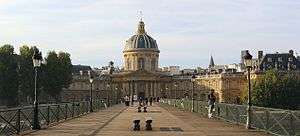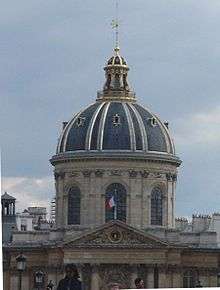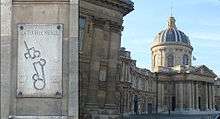Institut de France
The Institut de France (French pronunciation: [ɛ̃stity də fʁɑ̃s], Institute of France) is a French learned society, grouping five académies, including the Académie française.
 | |
 The Institut de France viewed from the Pont des Arts | |
| Formation | 25 October 1795 |
|---|---|
| Founder | National Convention |
| Type | Learned society |
| Location | |
| Coordinates | 48°51′26.07″N 2°20′12.85″E |
Chancellor | Xavier Darcos (2017– ) |
| Subsidiaries |
|
| Website | institut-de-france |
The Institute, located in Paris, manages approximately 1,000 foundations, as well as museums and châteaux open for visit. It also awards prizes and subsidies, which amounted to a total of over €27 million per year in 2017.[1] Most of these prizes are awarded by the Institute on the recommendation of the académies.
History


The building was originally constructed as the Collège des Quatre-Nations by Cardinal Mazarin, as a school for students from new provinces attached to France under Louis XIV.
The Institut de France was established on 25 October 1795, by the French government.[2]
In 2017, Xavier Darcos was named the Institut de France's chancellor.[3]
Académies

- Académie française (French Academy, concerning the French language) – initiated 1635, suppressed 1793, restored 1803 as a division of the institute.
- Académie des inscriptions et belles-lettres (Academy of Humanities) – initiated 1663.
- Académie des sciences (Academy of Sciences) – initiated 1666.
- Académie des beaux-arts (Academy of Fine Arts) – created 1816 as the merger of the
- Académie de peinture et de sculpture (Academy of Painting and Sculpture, initiated 1648)
- Académie de musique (Academy of Music, initiated 1669) and
- Académie d'architecture (Academy of Architecture, initiated 1671)
- Académie des sciences morales et politiques (Academy of Moral and Political Sciences) – initiated 1795, suppressed 1803, reestablished 1832.
Influence
The Royal Society of Canada, initiated 1882, was modeled after the Institut de France and the Royal Society of London.
The Lebanese Academy of Sciences, known officially by its French name "Académie des Sciences du Liban" (ASL), is broadly fashioned after the French Academy of Sciences, with which it continues to develop joint programs.
See also
References
- "L'Institut de France et le mécénat". Institut de France. Retrieved 9 March 2019.
- Planet, Lonely. "Institut de France in Paris, France". Lonely Planet. Retrieved 18 December 2017.
- "Xavier Darcos devient chancelier de l'Institut de France". FIGARO (in French). 12 December 2017. Retrieved 18 December 2017.
External links

- Official website (in French)
- Notes on the Institut de France from the Scholarly Societies project